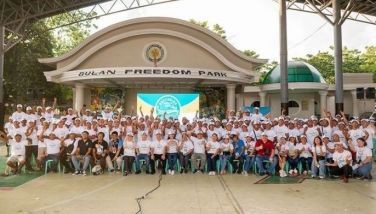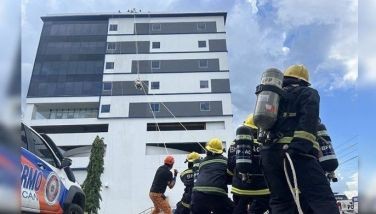Paoay in the sky
I had come in search of authentic puki puki.
But to brave the 12-hour long drive to Laoag, the northernmost city in Ilocos Norte, for puki puki (an eggplant salad) is as close to water torture as it gets for someone with an overactive bladder like myself. Aside from having to stock up on adult diapers, the situation was further complicated by my wife’s motion sickness during the extended road travel, coupled with my yaya’s insistence on using the Google Maps application on her I-Pahd which she purchased from Divisoria. Given the bladder, the belching and the backseat driving, we would probably get to Laoag in about three years.
Luckily enough, we were able to book Seair’s inaugural flight to Laoag (at a price almost comparable to a bus ride to Laoag) that was all of 90 minutes. I only had to go to the banyo on the plane 47 times!
I was welcomed to Laoag by having a faux cartoony bigote pasted on my naked philtrum. (Why, Laoag? Weren’t my exposed seven-inch-long chest hairs enough?) Apparently, the bigote is a tribute to Badoc, Ilocos Norte native Juan Luna (who, for the unflinchingly hip, now refer to him as Johnny Moon) — the first Pinoy to achieve international recognition for his art, which has become a signature of Ilocos Norte’s tourism campaign “Paoay Kumakaway.†His bigote has been the template of many famous Pinoys including Manny Pacquiao, Mr. Shooli and Mr. Suave. It was reported that even Gov. Imee Marcos was so obsessed with Johnny’s moustache, she said, “Asian men have no facial hair. So why did he have this bush?†(Do not go there, RJ. For the love of God, do not go there.)
From the airport, our hosts escorted us to our home in Laoag — the stately Fort Ilocandia Resort. Fort Ilocandia is a symbol of Spanish and Ilocano cultural heritage, halls filled with Victorian era-inspired paintings and a Chinese-themed gift shop. Kulang nalang the big wooden spoon and fork and a painting of “The Last Supper†in the lobby. For the more supernaturally curious among you, I’ve heard tsismis that there are ghosts lurking in the resort’s corridors. (See, this is the reason why you must always bring your yaya with you when you travel. Yayas are automatic mumu repellants. But don’t worry, if worse comes to worst, they can only scare you in Ilocano.) From the photo displays in the resort, you will appreciate the many prominent guests who have seen the mumus in Fort Ilocandia, including the Miss Earth candidates of 2003 and 2004, and the Revolving Doors of Vengeance (No, no, that is not a terrorist group. It is a Chinese soap opera. The stars of the soap went on a golfing holiday at the Fort).
Once we had settled into our mumu-free rooms, our hosts sat us down and proceeded to clog our arteries with orange empanada. What? Yes, yes: I am still vegetarian. After all, you can have empanada with double egg, double cheese and (para healthy naman) double vegetables. But, of course, when you multiply all those double-double servings, it equals several hundred arteries that clog blood flow to the pink parts. However, the empanada was merely the first belt-loosening food trip into Ilocano cuisine. Once we had been revived from our cholesterol-induced empanada coma, we were brought to La Preciosa restaurant in Laoag City, where we would consume foods that not only help minimize the effects of empanada on our system, but also whose names sounded terribly appetizing to Manila-based Dirty Old Men (DOMs). You see, these Ilocano dishes don’t need an introduction, they need religion. First up, was kabatiti (patola or sponge gourd) followed by utong (stringbeans) and, finally, the protein-rich puki puki. You weren’t sure if you were ordering food or foreplay (but the DOMs made sure to order two of each). Then once the hosts had called in the paramedics, the waiters brought out the kinamamatayang — este, walang kamatayang bagnet.
(There is a prevailing belief that Ilocanos are kuripot. But after seeing the richness of their diet, I am inclined to think that that’s merely an urban myth. They just don’t spend their money on luxury items. Rather, they spend their money on drugs like Lipitor.)
Da real Macoy
Our hosts took us on the “Marcos Trail,†which follows the life of the country’s longest-serving president. The trail started in a traditional “bahay na bato†in Sarrat where he was born. I read in one of the commentaries posted on the wall that, “at four years old, Ferdinand taught himself the English alphabet. At five, the young Ferdinand was not only a voracious searcher for knowledge, but he also excelled in various sports like pistol shooting, wrestling, boxing, horseback riding and racing.†Wow. That is pretty amazing for a five-year-old. At four and half years old, my daughter is just voracious. But she has learned the English alphabet by watching One Direction music videos.
From Marcos’s birth home, we dropped by the Santa Monica Church in Sarrat — a 17th-century church that combines elements of Baroque and Neo-classical architecture. The Sarrat church entered national consciousness when Imee Marcos had this once-ruined church reconstructed for her impending wedding to Greggy Araneta in June 1983. But what my three female readers may not know is that this church also has the longest recorded church aisle in the Philippines — a 137-meter dash — which gives the reluctant father of the bride ample time to snatch his daughter from the aisle should she harbor any second thoughts on the nuptials (Ha! I will never be that reluctant father of the bride! My daughter will be in a convent before she even reaches puberty). Incidentally, there are ruins of a torture chamber within the church grounds where criminals, subversives and would-be grooms were hung from the pillars.
After my wife unsuccessfully tested the torture chamber on my pink parts, we drove down to the “Malacañang of the North†(Balay Ti Amianan), the late President’s vacation house overlooking Paoay Lake. (There’s a myth that Paoay Lake was once a village filled with self-indulgent people who wore ostentatious jewelry and loud clothes. God punished these villagers by submerging the village and turning them all into fish. Some fishermen claim they have found fish that still had jewelry hooked to their scales. Upon hearing that myth, several of the DOMs left before they could grow fins.) After the EDSA revolution, Balay was transformed into a museum filled with Marcos political memorabilia.
In the first floor of Balay, we visited a guest room where all the showbiz personalities were billeted during campaign sorties with the late president. According to our tour guide, it was the late president who made pa-uso bringing artistas to campaigns (the artistas who campaigned hard enough in the 2013 elections to pay off their monthly housing amortizations owe a debt of gratitude to you, Mr. President). On the second floor, we were ushered into the former bedroom cum dialysis room that was converted to resemble his study room in Malacañang which not only had a collection of the books that he had written but also housed the actual table and chair from where he declared martial law.
As I glossed through the exhibits of Marcos’s photos with Richard Nixon, Mao Zedong, Emperor Hirohito, President Suharto, Fidel Castro and General Secretary Leonid Brezhnev, the engineering battalion that he sent to the Vietnam War and photos of the first batch of Overseas Filipino Workers who were sent to Saudi Arabia, one particular exhibit caught my eye: the OFW survival kit. Here are the Ilocano essentials to surviving life abroad: tabo, burbur towel, maleta, tampipi, armiles, merthiolate, abel kumot, Sto. Nino, tawas (to ward off malicious spirits and body odors), pamalo (is the spanking meant for mortification purposes of the pink parts while away from spouse?), hilod (so, if ever, the kalyos won’t be obvious) and, most importantly, a bullet.
Yes, a bullet.
The guide shared that Ilocanos bring a bullet for long-distance travel because they believe it to be an anting-anting.
(Imaginary conversation between fresh-off-the-boat OFW and US Immigration officer:)
IMMIGRATION OFFICER: Why in heck are you sneaking a single bullet into the United States!?
PINOY OFW: For protection, bosing.
IMMIGRATION OFFICER: Protection!? (Raises his hands in exasperation) I think we need protection from you!
PINOY OFW: Bosing, I think you need some tawas.
Pretty powerful stuff, these anting-antings. It’s a good thing that I’ve got one of those as well. It’s got the eyelashes of a goat. Wait, wait, is that an anting-anting or a bolitas? I get confused.
Our last stop on the trail was the ancestral home in Batac which has been reborn as the Ferdinand E. Marcos Presidential Center. The Center showcases the late President’s personal life — from the preserved desks of his early school years under the Thomasites to a replica of his jail cell where he was studying for the bar exams to his 11-day romance with the former First Lady to his obsession with the number seven and even to Marcos fashion (yes, Marcos fashion). At the end of the visit, we even had the opportunity to visit the mausoleum. (Interestingly enough, the late President’s embalmer and an “embalmer to the stars†offered his services to embalm the body of President Hugo Chavez of Valenzuela. I would like to recommend some stars to the embalmer whom he might want to embalm before their expiration date.)
Dune Lang
After leaving behind several DOMs at the mausoleum who wanted to get embalmed in body parts that they had not used in several years, twilight welcomed us to our final destination for the day: the Paoay Sand Dunes. It doesn’t get any more surreal than these sand dunes — 84 square kilometers of arid desert-like beachfront whose constantly changing landscape is shaped by the prevailing winds of the South China, este, West Philippine Sea. And just how surreal are the sand dunes? This was the location of the 2011 remake of Temptation Island (I auditioned for the part of the giant fried chicken. I didn’t get it).
Incidentally, the twilight-ish atmosphere of the sand dunes served as the perfect backdrop for Nora Aunor’s 1982 award-winning movie Himala. Inspired by both the critically acclaimed film and the Burning Man Festival in the Nevada Desert, Gov. Marcos spearheaded the now yearly “Himala Sa Buhangin†music and arts festival in honor of La Virgen Milagroa, the patroness of Ilocos Norte. Taking a cue from the movie’s classic line “Walang himala!†the attendees were encouraged to shout instead “May himala!†(these are also the classic lines of losing candidates in local elections).
The highlight of last year’s festival was the construction by installation artist Leeroy New and the Gerilya Artists Collective dubbed “Chrysalis†which was made of all-natural material and represented the galleon that brought the statue of Virgen Milagrosa to Ilocos Norte (we suspect that this is the same galleon that stranded the ladies in Temptation Island).
But the real adventure was getting to the art piece hidden among the dunes. We boarded a 4x4 and were told that we would be riding it like a roller coaster but minus the seatbelts, the tracks and the medical insurance. Relying purely on my grip upon the bars that ran across the front seat of the 4x4 to keep me from flying into a sea of sand, we crept up and zipped down wannabe sand mountains, and crisscrossed long-stretches the undulating sand formations on a ride that was bumpier than EDSA after heavy rains. I belatedly realized that I shouldn’t have screamed too much during the ride because I inadvertently swallowed so much sand that I would be pooing glass for the next several days. After the ride was done, I asked my yaya to perform an impromptu physical examination on me to check if all my internal organs were still in their rightful places. The next time I take a 4x4 ride on the dunes, I will make sure to wear a supporter.
But the ride was well worth having my spleen where my right lung used to be when we finally saw Leeroy’s haunting skeletal galleon slowly deteriorating under a gray-blue sky. (I think this is where most of the mumus migrated to from Fort Ilocandia). After taking 340 selfies beside the art piece and tweeting it to all of my 14 followers, we re-boarded the 4x4 to head back to the foot of the sand dunes. When we arrived back in the hotel, I was scrubbing sand from pink parts that I never knew I had.
Speaking of pink parts, I hope my wife enjoys my lucky bolitas. I think it goes well with my Johnny Moon bigote. I can wear them both while we relive our visit to Laoaog while eating homemade puki puki.
* * *
In celebration of the La Virgen Milagrosa Festival, the next “Himala Sa Buhangin†festival returns to the Paoay sand dunes on May 25, 2013.
For more information on flights to Laoag, visit www.facebook.com/flyseair
For comments, e-mail Ledesma.rj@gmail.com or visit www.rjledesma.net. Follow @rjled on Twitter.




















